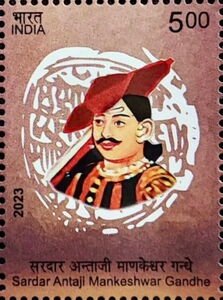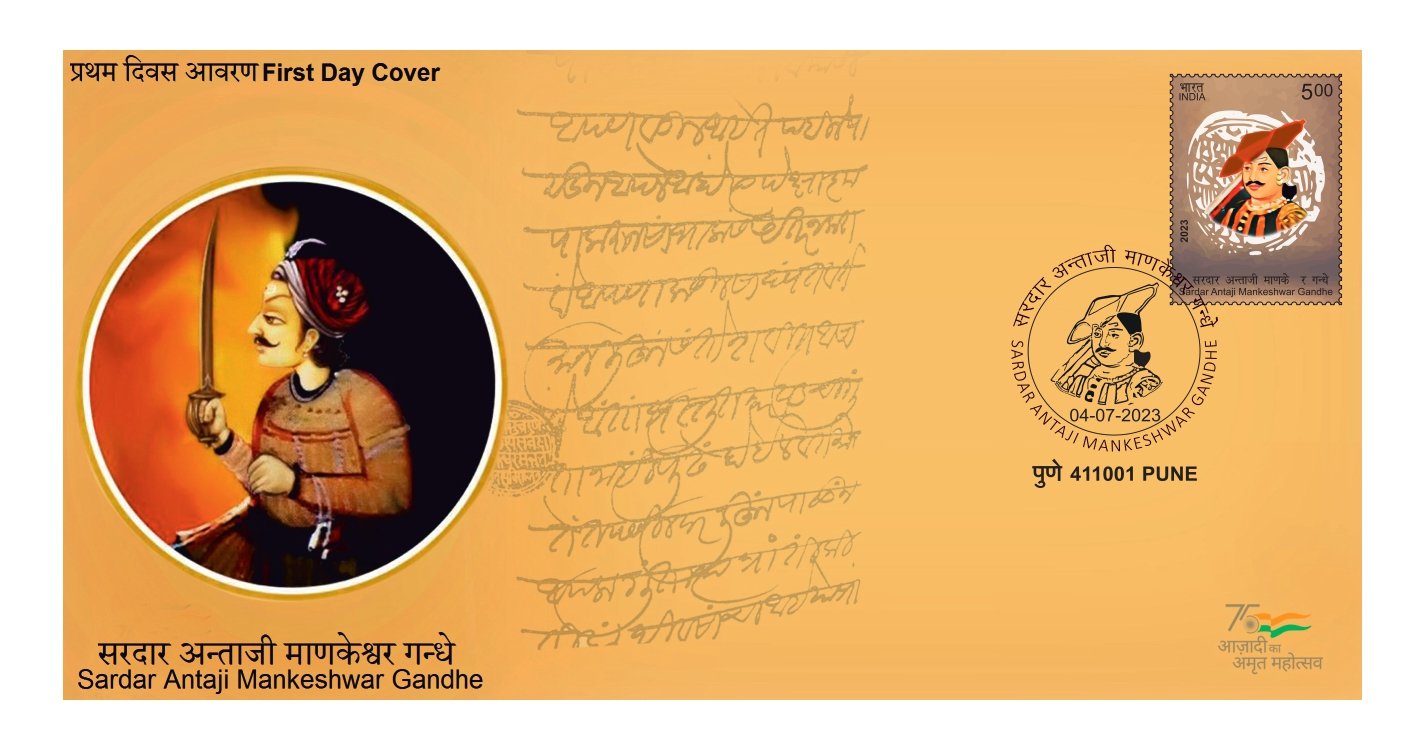Sardar Antaji Mankeshwar Gandhe

Technical Data
| Date of Issue | July 4, 2023 |
|---|---|
| Denomination | Rs. 5 |
| Quantity | 301,900 |
| Perforation | 14 |
| Printer | Security Printing Press, Hyderabad |
| Printing Process | Wet Offset |
| Watermark | No Watermark |
| Colors | Multicolor |
| Credit (Designed By) | Ms. Himani Ms. Nenu Gupta |
| Catalog Codes |
Yvert et Tellier IN 3560 Stanley Gibbons IN 3860 Colnect codes IN 2023.07.04-01 Michel IN 3901 |
| Themes | Commemoration | Famous people | Headgear | Men | Military Officers |
Early Life and Education
Sardar Antaji Mankeshwar Gandhe, the great commander of the Delhi-based army of the Maratha Empire, was born in 1695 in Supa province, Ahmednagar district, Maharashtra, into a humble farmer’s family.
During a famine, he moved with his uncle to Kanauj in North India in search of livelihood and education. There, he studied weapons and scriptures (Shastra) under Pt. Ramchandra Bhatt and imbibed Sufi music from Haiti Baba, shaping him into a unique blend of warrior and cultured leader.
Rise in the Maratha Empire
His talent was recognized by Shrimant Shahu Maharaj, grandson of Chhatrapati Shivaji Maharaj. After Shahu’s coronation in 1708, Antaji was taken into his personal service and later honoured with the title of Sardar (Knight) to aid in the empire’s expansion.
When the Peshwa institution was established in Punavadi (Pune), Antaji’s role grew immensely, and in due course, he rose to prominence as one of the key figures in the Maratha administration.
Governor and Commander-in-Chief
As the Marathas extended their influence into North India, Antaji Mankeshwar Gandhe was appointed Governor of Delhi. Under the Ahmadiyya Agreement of 1752, he became the commander-in-chief of the Maratha army in Delhi.
He served as Governor for 21 years (1740–1761), a feat unmatched since the time of Prithviraj Chauhan. By hoisting the saffron flag across North India, Antaji ensured stable governance and safeguarded Hindustan from repeated foreign invasions.
Military Achievements and Administration
From 1729 to 1757, Antaji led the Maratha forces in several decisive victories against invaders. He set up Kamargaon near Ahmednagar as his administrative centre and built the Garhi Fort. His leadership in both battle strategy and governance is remembered as exemplary even today.
Twice, he successfully repelled Ahmad Shah Abdali from Hindustan, protecting the sovereignty of the Maratha Empire.
Reformer and Visionary
Beyond his military glory, Antaji was a social reformer. In 1754, after the martyrdom of his son, he took a strong stand against the practice of Sati Pratha and issued orders prohibiting it, making his family and army follow the reform.
He was honoured with the Saptahazari Mansab by the Emperor and also established his own coat of arms and administrative seal, reflecting his authority and vision.
Martyrdom at Panipat
On 18 January 1761, while returning towards Delhi after the Third Battle of Panipat, Antaji Mankeshwar Gandhe was ambushed and martyred near Farrukhnagar. His sacrifice became a symbol of loyalty, bravery, and unyielding dedication to the Maratha Empire and Hindustan.
Legacy and Honour
Sardar Antaji Mankeshwar Gandhe is remembered as one of the bravest defenders of India during the 18th century a warrior who combined valour, vision, and reformist ideals. His story continues to inspire generations.
In his honour, the Department of Posts issues a Commemorative Postage Stamp on the occasion of his 261st death anniversary, saluting his unwavering service to the motherland and his fight against foreign invaders.
First Day Cover

